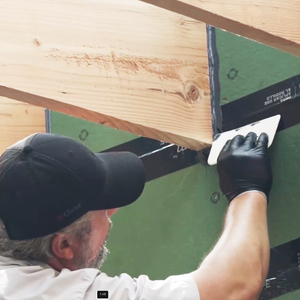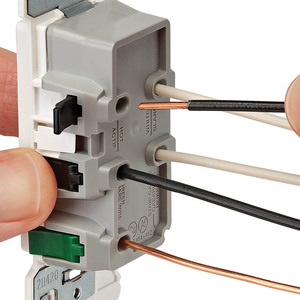Customers I installed windows for would like me to trim the inside. I’m feeling up to it, but only have an 18g brad nailer for small finish work (although it does go to 2 inches). Any problem using the 18g for both attaching casing to jamb (1 inch brads) and wall(through the drywall, 2 inch brads)? Before you yell, I read the archives, but did not detect a consensus. I know I probably *should* just buy a 15 guage nailer, but I’m cheap, and the 18 gauge nails are easier to hide!!!
Thanks. . .


















Replies
The 18 ga. probably doesn't have quite the holding power of the 15, but you're only holding the casing to window and wall. Have at it.
__________________________________________
Remodeling Contractor just outside the Glass City.
http://www.quittintime.com/
I have to differ with Calvin. Trim is all I do, and I would not feel that I could do a good job with just the brad nailer. With my Senco SFN40 (plenty of other good choices, many of them cheaper) you can lean on the rubber foot to press the outside edge of the casing down flat, and then the nail has enough holding power (you really need the surface area of the fatter shank) and head surface area to keep it there.
I have a splitter after my first length of hose, then 2 lighter hoses. The inside edge of the casing, if it's thin like on a conventional 2-1/2" profile, gets the brads first, to align the piece to the jamb. Then the outer edge gets the bigger nails. Then the corner, if mitered, gets pinned both directions (glued, of course).
Who's doing the painting, or whatever finish it's getting? A pro painter will expect to see those larger holes anyway, and will think of them as normal.
The 18 ga nailer is fine, add hand nails on the outer edge were the studs should be. I have all the nailers you could want, but I only had an 18 ga for years. I used a nail spinner in an electric drill, or just a twist drill.
I'm curious --- if you installed the window yourself, what did you use to nail in the exterior casings?
I haven't had good luck with the holding power of 18g nails. At a minimum, I would use a 16g gun.
I don't know what line of work you're in, but if you plan to do any amount of finish work in the future, a larger nail gun would be a good investment at only $200 or so. I have four now: air guns in 18g, 16g, 15g, and a Paslode in 16g. If your work doesn't typically necessitate a compressor, then the Paslode might be a good option for you, too. It costs more, of course, but it sure is nice to leave the compressor and hoses at home on a small job.
Hope this helps.
Ragnar
I hung the Andersons using the nailing flange; no casing per se around them. The casing will be a plastic j-channel like casing made for vinyl, so no trim nails there. In the past I've just hand nailed them, wouldn't even think of using the 18g on them if they were attached through the brickmold/casing, but on interior, I figured why not.
Thanks for the reply -- didn't realize you were using vinyl on the outside.
I guess I should have asked what size and type of casing you are applying. My work typically calls for 1x5 or 1x6 casings, and I am usually using solid wood. Therefore, a 15g or 16g nail works well for me.
If you are using "small" trim (i.e. 1/2 x 3), maybe you can get by with the 18g nails.
Still, I'm hesitant. I've used the 18g gun for 1/2 x 2 window and door stops, and have seen some loosening after time. I'm now going back to the 16g gun for the smaller stuff. The only time I use the 18g gun is for glass stops or anything that is small enough (smaller than 1/2 x 1/2 in cross-section) to warrant concern about splitting with the larger nails.
Ragnar
I also trim for a living. Though I usually use a 16ga I also use a 18ga without problems as long as the molding lays down nice and does not need to be pulled in tight because of the jamb - to - drywall conditions. When I have to use MDF the 18ga makes it easier on the painters.
Hi all,
I find it hard to believe that so many of you espouse nailing casings to walls with 18ga 2" brads. Especially 3/4 lto 7/8ths thick casings. Particularly where doors are concerned, the casing is all that holds the jambs true. As it is, with modern construction where rock exists between casing and studs, there is a 1/2" of marginal space which has zero holding power in tension and very little shear resistance, between casing and stud. The minimal shear resistance offered by the rock against 15 or 16 ga nails is bad enough as it is: 18 ga brads act like a cheeze cutter. Every time someone leans against the door, or the vacuum cleaner hits the jamb leg, or the door gets slammed , or bumped, or just opened and closed, those little brads cut more rock and get looser and looser.
Before you know it, the top of the door is hitting the jamb. Windows casings too, as far as I'm concerned, should also be securely fastened to studs, if for no other reason than help keep them tight to the wall so the caulk and paint joints don't crack so badly.
Clampman
Thanks Clampman!
I use 15ga nails in my 16ga Paslode because the 16ga nails don't impress me. I can't imagine using 18ga unless the casings lay neat and I added some Titebond or hand nailed after sticking it with the 18s. I'm really amazed at the number of guys who OK it. But then I'm amazed at some of the work I'm called on to fix later when someone didn't do right too..
Excellence is its own reward!
"The first rule is to keep an untroubled spirit. The second is to look things in the face and know them for what they are." --Marcus Aurelius
Right now the painters are filling my work. When they are finished laquering you would be very hard put to find a nail hole. I've been back to work in homes I've finished years ago and trim is tight as the day I left. Maybe someone shold do a study on the holding power of sprayed laquer and are the caulked edges on paint grade trim stronger than screws?
The painters are already upset with the odd exposed 16ga I'm using. If I used 15ga or started hand nailing there would be a riot (quite possibly a very nasty visit from the site super) and I would most definately be back-charged for the extra work I left behind for the painters.
18ga and a few dabs of glue Gordsco
If it works, fine. Are you saying that you are depending on the laquer to hold it in place to some degree?
I don't want to be argumentative but from my viewpoint, It is the carpenters job to make the wood fit and to make sure it stays where we put it. After we're done, it's the painter's job to make it look good. Some supers think it's their job to see that it looks good as fast and cheap as possible, with a care for wheather it falls apart in a few years.
If you can hold it together well enough to suit your self as though you will be the owner AND keep the painters from whining, my hat's off to you!.
Excellence is its own reward!
"The first rule is to keep an untroubled spirit. The second is to look things in the face and know them for what they are." --Marcus Aurelius
How much is enough?
I suppose if you were seriously worried about your window casings, you could fasten them with drywall screws and cut plugs to fill the holes. In the old days, a solid wood trim strip was installed over the lath around windows providing a continuous nailing strip for the casing and to set the level of the plaster. Of course you had to nail the bejesus out of everything because of the frost heave around the windows. (no cenral heating, no insulation) They also had a solid wood backer around doors and behind the baseboards. Sounds labor intensive and expensive but hey, it will last 500+ yrs. Would anything less be crap?
18ga and dabs of glue, (on 3/8" to1/2"casings) not a window to repair since I started doing it this way 5 yrs ago... things still solid as H, to tell you the truth I was apprehensive at first, but just try to pull one off, I'm now a believer...Who says you can't have speed and quality?...Gordsco
Hey Piffin,
You put 15g nails in your 16g Paslode? Doesn't that cause problems? My 15g nails are collated on an angle, and have small heads (they look much different than the 16g nails, which are collated horizontally). Are the nails you get different?
It's the gas fired Trimpulse. When I bought it the guy said that the fifteens he had (generic or Spotnails) would work just as well.
No angle, this is the straight line one. tiny T head.
It's been shooting them for what, maybe six or seven years now. I like that they don't bend in harder wood or when hitting a knot. Less likely to blow out the side when edge nailing..
Excellence is its own reward!
"The first rule is to keep an untroubled spirit. The second is to look things in the face and know them for what they are." --Marcus Aurelius
Clampman I disagree: I hand the doors with 15ga 2 1/2" with plenty of shims - that is what holds 95% of the door. The casing nails don't need to hold up to that much stress if the door is hung correctly, they just keep the jamb straight. I don't understand the windows either- what kind of stress are they under? One point I would agree is with 3/4" and thicker, personaly I use 16ga or 15 ga for those but that is because they tend to need to be hels tighter to the jamb. Just ny opinion.
Paul:
I understand your argument and I think it is valid. You are saying that if you adequately shim and nail the door jambs, then the casings become essentially decorative, and are not necessary to provide additional strength. But let's also make it clear that you'd better be using something bigger than 18g brads for this purpose (which you are).
A second way of installing a door jamb is to put in a limited number of fasteners through the jamb, and then use a well-nailed casing as a structural bridge to the framing. This way works, too. I probably prefer this second method because I can tweak the jamb a little bit as I install the casings, which allows me to set the reveal between casing and jamb very accurately.
Just for fun, here's an instance where the casings must be used for structural strength: traditional double-hung windows. To provide a chase for the counterweights, you can't shim and nail the jambs directly to the framing. I do a lot of traditional windows, so maybe that's why I also tend to view casings as somewhat structural.
Regards,
Ragnar
Edited 11/22/2002 9:15:37 PM ET by ragnar
Agreed. I have doors in my house that is 25 years old and they work just fine. Took one out a while back - it was not shimed, had a few nails through the jamb and most through the casing - just as you described. I don't hang doors that way but I know it works, even after all that time.
Good point on the old windows, but as for doors you can tweak the reveal on a door jam the same way if you hang to jam while the door is on the hinges, just swing the door closed to make sure you have the reveal you want then shoot the jam with shims in it. Maybe its just me but I would rather use the jam to make sure the door is secure then rely on the casing
Yeah, I agree with you on the door jambs; that is, I secure the jamb enough to make it secure with or without the casings.
If I'm using my own jambs, I like to put a few 3" screws through the centerline of the jamb, through the shims, and into the framing. When I'm done, I install stops which cover the screw heads.
Regards,
Ragnar
18's on the inside, 16's on the outside, to jambs that are screwed in solid (I don't buy the 'hang the door from the casing' theory, and there was a big debate here when FHB published that gary Katz article.....but neither am I a production trimmer).....a bit of glue or a very occassional handnailed bigger nail covers the rest. I need to add a 15 ga., but it's for baseboard and flooring, not casing.cabinetmaker/college instructor. Cape Breton, N.S
Coming from you that means a lot, especially when combined with a little glue.
Now, to expand - from my limited experience with 18s - on hard woods they often fold up and create a bigger flaw in the wood surface on harder woods. Will certain guns shoot the 18Ga better in oak or anything harder than pine?.
Excellence is its own reward!
"The first rule is to keep an untroubled spirit.
The second is to look things in the face and know them for what they are."
--Marcus Aurelius
I might need to duck my head on this one but.. My brother bought a Dewalt 18ga and it is great. Sets the nail perfect everytime. Its better than my Paslode, Senco Finish pro, and Porter Cable.
Thanks....just one guys opinion though. As far as guns go, mine aren't fancy....they're Primes, which are supposed to be Duofast clones, made in the same factory to same specs (I like Duofast, but I had to go with guns that were available and supported locally, and in finish guns, that really means Prime and Porter-Cable (I have a bunch of P-C's here in the school shop). Better choice in framing guns. The price of Senco here is completely ridiculous).
I'd prefer to use 16's for everything, but to much trouble with splitting. I like 15's, but I know I wouldn't be able to get them where I want a nail a lot of the time. Neat tip about being able to fire 15's from a 16 gun; never would have occurred to me.cabinetmaker/college instructor. Cape Breton, N.S
Neat tip to avoid splitting, square the chisel point to the work.
I won't comment on the 18 gauge trim fastening, other than I have never had a painter complain about my 15's. (not that I would listen without scheming a prank for them, or feeling like I have to tell them how to do their job.)
Neat tip to avoid splitting, square the chisel point to the work.
That's a great thought! Thanks. I never thought about studying the chisle direction and how it goes through the wood..
Excellence is its own reward!
"The first rule is to keep an untroubled spirit.
The second is to look things in the face and know them for what they are."
--Marcus Aurelius
Yup, know that one.cabinetmaker/college instructor. Cape Breton, N.S
Not sure I understand why the casing would be holding the jam true, I'm not advocating using 18s but last I checked casing isn't supposed to be structural.
I also trim for a living and I would say that unless you are installing casing thicker than 5/8" an 18ga brad nailer should do the job just fine. Although I routinely fasten casing 3/4 to 7/8 with 2" 18ga pins I will pop a few 16ga 2 1/4" if I find the moulding has a twist and needs to be flattened. A bit of glue on the drywall side of the moulding doesn't hurt either.
If you are using standard casing 2 3/4" X 1/2" thick I would only use 1 9/16" 18ga pins with a few dabs of carpenters glue on the drywall side. ( and miters )
sometimes board sometimes knot
no problem---go for it